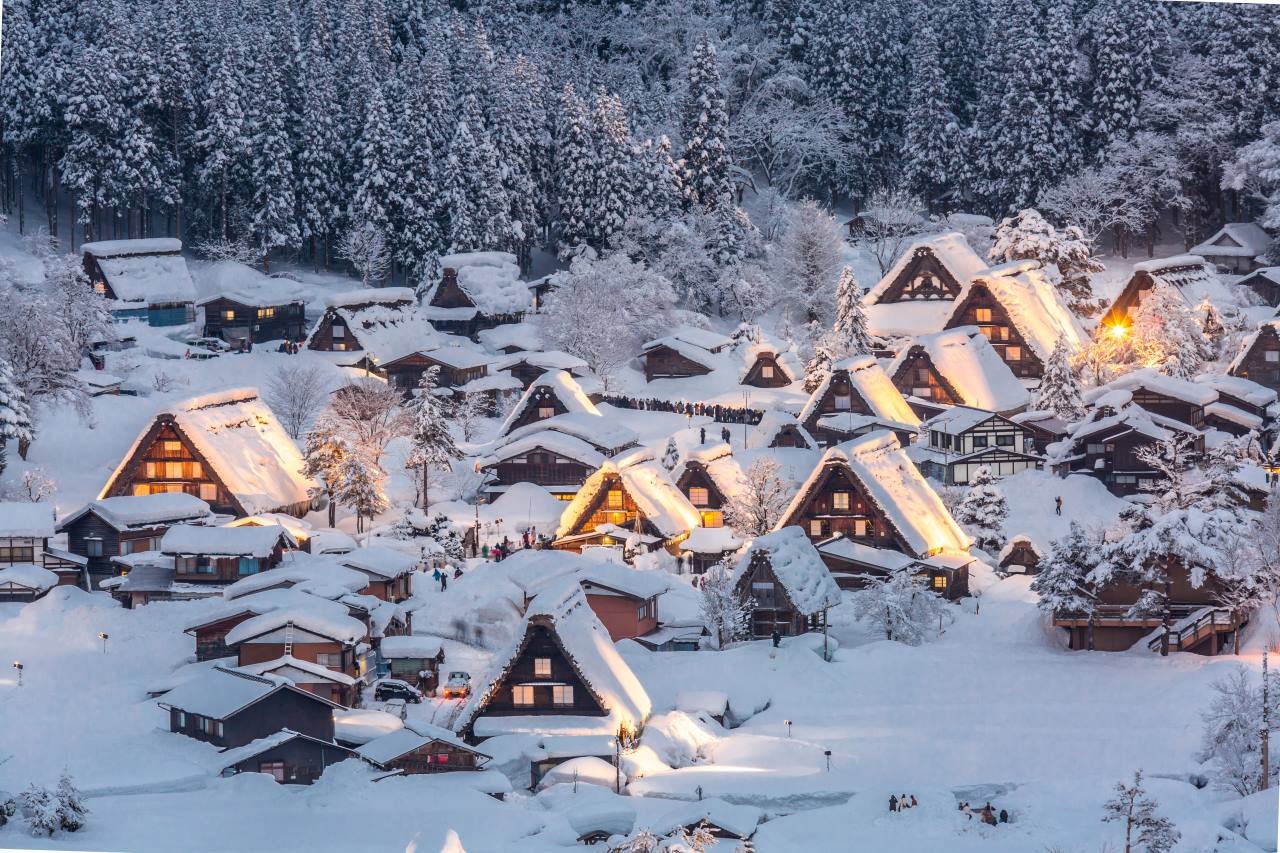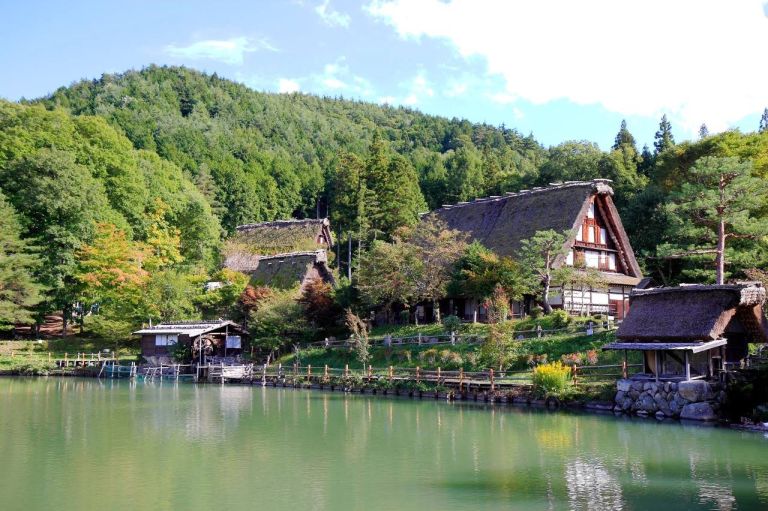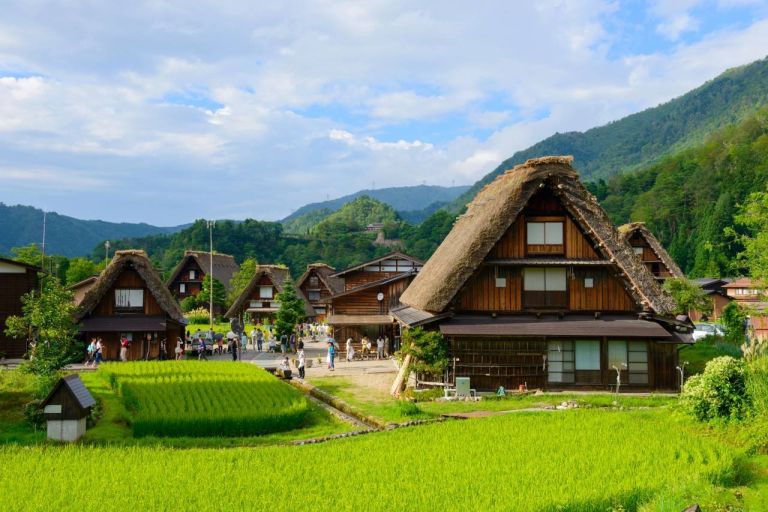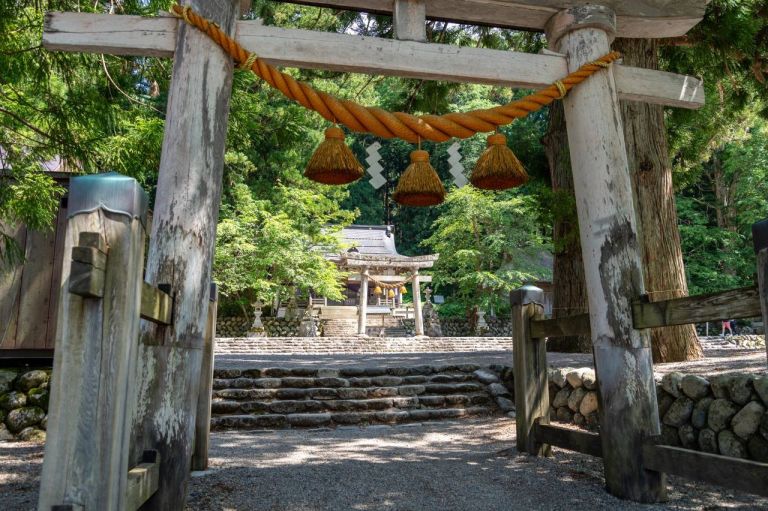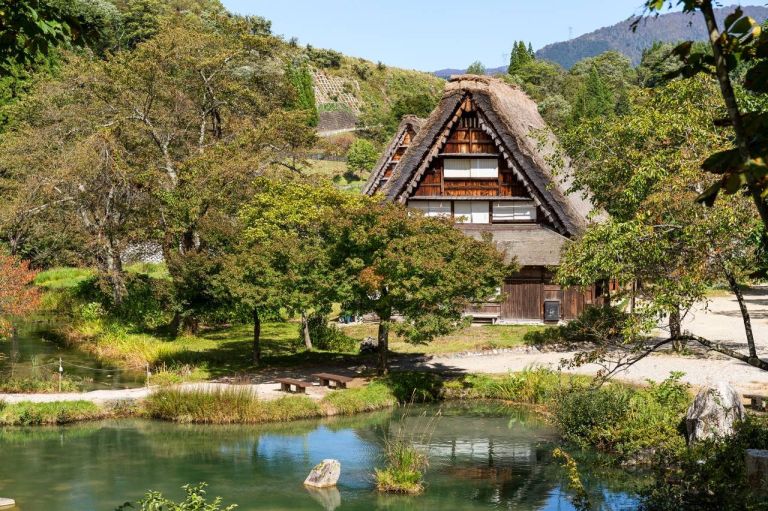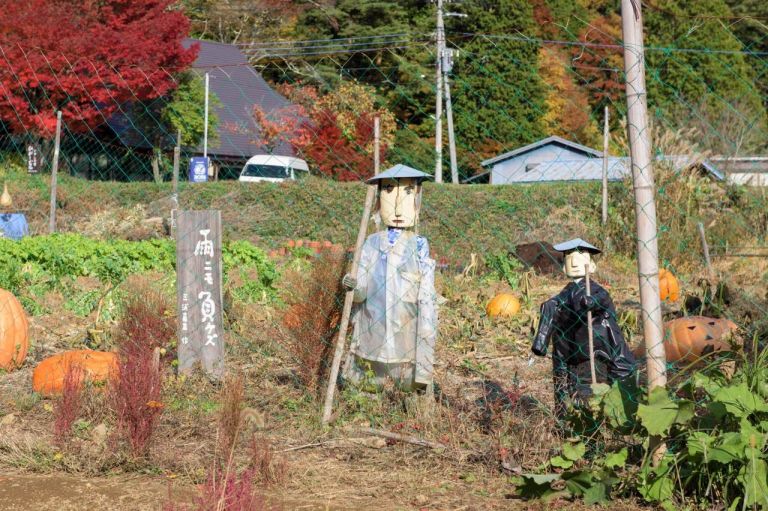Shirakawa-go is one of those places that, as soon as you see them, seem to come straight out of an ancient memory of Japan. In the valley of the Shōgawa River, at the foot of sacred Mount Hakusan, wooden houses with steeply pitched thatched roofs draw an unmistakable profile: it is the gasshō-zukuri style, "like hands joined in prayer." It's not just poetry of form: those lofty roofs, handwoven using techniques handed down for centuries, slide away meters of snow and, at the same time, create a great volume of air that insulates and protects. Inside, the heart is the irori, the suspended hearth from which smoke rises slowly: it smokes the rafters, keeps out moisture, preserves the thatch. The result is an architecture at once beautiful and functional, balanced like a haiku. Many of the structures are assembled with joints and bindings, without a nail, and have survived two centuries of winters and earthquakes by standing like small cathedrals of craftsmanship.
The main village, Ogimachi, is the best-known face of the UNESCO site (recognized in 1995): a fabric of rice paddies, vegetable gardens, canals, granaries, and farmhouses that tell the story of rural life in the old Hida province. Architecture here is not scenography, but a sum of necessity transformed into beauty. The upper floors once housed sericulture: the dry heat of the attic was perfect for raising silkworms, one of the economies that allowed this remote community to thrive. As you walk through the compact streets, past gravel courtyards and small gardens, you realize that Shirakawa-go is not a still museum: it is a living village, where the key word is yui, cooperation. The same one you see when neighbors organize to re-roof a thatched house, when fire alarms are tested, when people come together to preserve the landscape as a common good.
Historical value is prevalent in every building, but some houses open a privileged window to the past. The Wada-ke, among the largest, shows the wisdom of carpentry with inky-black beams and steep stairs to the silk floors; the Kanda-ke holds carvings of 19th-century carpenters, almost a signature in the wood; the Nagase-ke tells the story of a family of doctors through tools and remedies from the Edo era. Just outside, the Gasshō-zukuri Minka-en brings together houses and outbuildings moved here to save them: warehouses, workshops, a small temple, the tools of the farming and mountain world that made these valleys a niche of self-sufficiency. Climbing up to Shirayama Viewpoint, the gaze embraces the whole: rooftops like arrowheads, the grid of fields, the river cutting through the basin. It is the glimpse that binds nature and culture into a single image.
The artistic dimension of Shirakawa-go is in the gesture of making: in the weaving of the straw, the warping of the ropes, the geometry of the trusses; in the laconicity of the wooden interiors, tatami and shōji, where emptiness is part of the composition. Temples, too, tell of a sober and powerful style: at Myōzen-ji the monastic complex and former monk's residence, now a museum, show the spirituality that nurtured the community as much as a successful harvest. Then come the seasons to finish the picture: pale cherry trees in spring, a palette of greens gliding through the rice paddies in summer, the gold and rust of momiji in autumn, and finally winter that turns everything into a Nordic nativity scene. When, on winter evenings, the houses are lit up and the snow muffles the sounds, the village seems suspended out of time.
The culture here has the flavor of communal rituals. In autumn, during the Doburoku Matsuri, people taste unfiltered sake made with special permission-a thick, milky, almost primitive drink that accompanies songs, shishimai lion dances and offerings to the kami. It is a festival that binds together agriculture, faith and identity. But you encounter the same idea of everyday hospitality-the omotenashi-if you choose to sleep in a minshuku gasshō-zukuri: futons stretched out on straw-scented tatami mats, hot baths that melt away fatigue, a family dinner that is storytelling and welcoming. It is in those evenings that you really understand how the village has survived: by shared labor, by the ability to adapt, by the pride of guarding and passing on.
Gastronomy is also an important chapter in local history. The mountain climate has taught people to value what nature has to offer: forest vegetables (sansai) marinated or in tempura, river fish such as grilled ayu, rice from the terraces, meaty mushrooms, and robust miso-jiru soups. The nearby tradition of Hida brings Hida-gyū beef to the table, tender and rich, perfect on the griddle or in steaming nabe; hōba miso, miso paste smeared on a magnolia leaf and slowly heated to a fragrant cream, accompanies vegetables and tofu with a deep flavor; mochi and rice cakes sweeten the winter. Doburoku, with its rural character, is the identity drink; the clearest local sake, served cold or lukewarm, on the other hand, tells of finesse and patience. Each mouthful is a bridge between geography and memory.
Visiting Shirakawa-go also means learning to read the layers. UNESCO protects its entirety-architecture, agricultural landscape, knowledge-but the real strength lies in the interweaving of what you see and what you don't immediately see: a community that meets monthly to discuss conservation; unwritten rules-don't sell, don't lend, don't destroy-that protect homes the way family histories are protected; crafts that are reinventing themselves to stay alive, such as the master strawmakers who train young apprentices while they hope to grow straw again in the valley. It is a delicate balance, tested by tourism, snow, and weather.
Yet as you step out of the open-air museum, or close the sliding door to your minshuku room, you get the sense that this balance, for now, holds: because here beauty is not a luxury, it is a necessity. Shirakawa-go lives precisely in this: in the ability to transform the harshness of the mountains into shared culture, and the simplicity of things into a precious legacy.
Ph. Depositphotos

